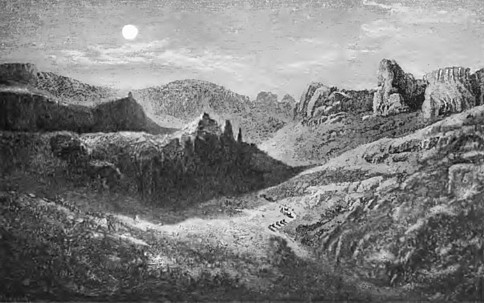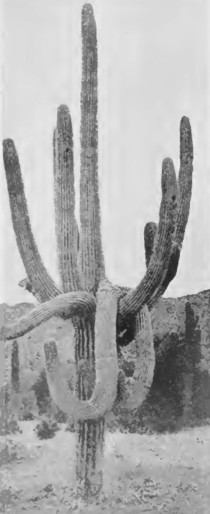However rich Arizona mines have been, there is a suspicion that, before the days of copper, their net proceeds would hardly equal the amount of money furnished by ignorant investors toward the development of prospects that have never amounted to anything. Still worse, many of these enterprises have been most unblushing frauds, the money stolen from the unwary after advertising campaigns that claimed enormous riches for the mine that happened to serve as bait, used by schemers, who found their victims in the eastern states of the Union. Today such work would hardly be done, for the United States authorities keep close watch upon any extravagant advertising, and make investigation as to the basis of the claim. One of the frauds in 1899 grew to such large proportions that Governor Murphy considered it his duty to issue a formal letter of warning, addressed to outside investors in Arizona mines. This letter brought down a storm of protest, and Murphy was accused of a jealous desire to ruin Arizona mining. Within a few months, however, it was demonstrated that his action had been dictated by a true sense of local patriotism. The particular swindle to which he referred was the Spenazuma mining project, developed by "Doc" Flowers, who already had made an enormous fortune in the sale of proprietary medicines. The Spenazuma, which was exploited as the greatest mine in the world, was in Graham County and was a very ordinary mine indeed. Ore samples that were sent east and that were piled on the mine dump for the inspection of committees of stockholders were brought from other mines of far greater value in the Black Rock district.
The expose came through a newspaper man, Geo. H. Smalley of Tucson, who furnished Governor Murphy with the information that led to the publicity given. But Flowers sold stock, at advanced prices, even after his methods had been shown up in eastern journals. Flowers could not buy Smalley off and soon thereafter had to quit operations in the Southwest. One amusing feature of Flowers' operations on the Spenazuma was a fake stage hold-up, thoughtfully provided for the benefit of a number of prospective investors. He hired a number of cowboys to hold up the caravan of coaches, but the defenders succeeded in driving off the bandits, who, later, however, couldn't keep from joyously narrating the features of their employment. Flowers was a man of true Wallingford stripe and found opportunity for making money on every corner. In 1890, while under indictment on a charge of selling fraudulent stock, and while under bond for $50,000, he floated in Philadelphia a company for the promotion of a method of making gold. He was arrested on several charges of grand larceny, but he succeeded in escaping to Canada. Slow-footed justice at last came to him, as late as December of 1914. After extradition from Canada, he went to trial at an eastern point, and at the age of 70 years was sentenced to two years in the penitentiary. If he had stolen a pig his sentence would, probably, have been at least five years.
In 1892 Dr. H. H. Warner of Rochester, New York, an individual famed for his observatory, his bitters and his pills, bought of John Lawler and Judge Ed Wells the Hillside group of mines in southwestern Yavapai County, paying $50,000 cash on the price of $450,000. The property then was stocked under the name of the Seven Stars Gold Mining Company. Ordinary stock was sold at $1 a share, but beyond this was issued a block of 100,000 shares at $5. on which Warner, then believed worth millions, personally guaranteed annual dividends at 13 per cent. Warner failed soon afterward and the bubble burst and the mine, with much added development, went back to the sellers, despite the protests of the stockholders.
In clearing up the affairs of the George A. Treadwell Mining Company, which had a weird sort of reduction plant near Humboldt, it was claimed by stockholders that the promoters of the company on stock sales aggregating about $1,000,000 had cleared up a "profit" of $500,000, while not more than $100,000 had been spent on the property. One of the promoters, a New York lawyer, was said to have been paid counsel's fees of $36,000. One Eastern firm of brokers secured bonds or options on a number of Yavapai County mines, of the "has-been" class, of former leaders in the silver production of Arizona. These old mine workings were cleaned out to an extent, and some of the cleverest of advertising, mainly beautifully printed circulars and letters, was sent broadcast, inviting investment, while plans of the most gorgeous description were announced of reduction works that would make rich the miners of the entire country. But little was done after the stock-selling campaigns. With a stock seller it mattered little whether his mine had any worth or not. He never did more mining than was necessary to make a showing for his campaign. This condition,, however, never has been peculiar to Arizona. Such schemes were worked much more generally, and with even greater success to the promoters, during the days of heavy mining activity in Alaska and Nevada.
One individual who had a mine near Prescott issued a unique prospectus full of quotations from the Bible and of glittering generalities concerning the wealth that was to be secured in the marvelous mine exploited, which later seems to have dropped from the public eye. Within the prospectus appears the following gem:
Come, little brother, and sit on my knee.
Until both of us wealthy will grow, you see
If you will invest your dollars with me,
I will show you where money grows on the tree.
One early day promoter issued a mining prospectus wherein was set forth, "experts agree that a sheet of native gold will be struck at no great depth." A three-foot vein usually was enlarged to a 100-foot dyke and few of these writers permitted their gold quartz ore to ever run less than $100 to the ton. Some of them, even far down in Sonora, were declared they were on the same mineral belt as the United Verde and dime-novel tales usually were recited concerning the discovery of these wondrous and inexhaustible bonanzas. Early in 1899 there was excitement along the Grand Canyon, where had been staked out a large area of the lime-carbonate capping of the region which was thought to be valuable for its content of native platinum. The bubble was punctured by Prof. W. P. Blake, director of mines at the Territorial University, who after careful assays reported that the "ore" sent him was a carbonate, containing only silica, calcium, magnesia, iron and a little alumina. It was not platinum ore, in fact no trace of platinum could be found in it, though similar rock submitted elsewhere for analytical testing was reported to have returned values of up to $300 a ton in platinum. While deploring the influence of his report upon the prospectors who thought they had found a new source of wealth, he also said, "the people of Arizona generally do not propose to profit by the use of ignorance, pretense or misrepresentation." It is probable that the excitement all started through efforts made to assure trail holdings down into Cataract Gallon.
Another notable swindle was that of the Two Queens and Mansfield Mining companies. The former had several prospects, near Winkelman, about 100 miles southeast of Phoenix. The latter had a mine in the Patagonia district of Santa Cruz County. The Post Office department secured the arrest of several Kansas City (Missouri) stock brokers, who had been selling shares in the two companies, by means of extravagant full-page advertising. As is usual in such cases, strong defense was made on the basis of testimony taken in Arizona, but the defendants finally were convicted and were sent to jail in May, 1909, though, as usual in such cases, they received relatively light sentences.
Another typical instance concerned a temporary resident of Wiekenburg, Arizona, who had bought a mining claim a few miles from that town. He sold at least $100,000 worth of stock in several villages along the Hudson, near "West Point, and, in order to show his good faith, brought out a Pullman carload of selected stockholders to view the wonderful mine from which he was to make them fortunes. The mine was viewed, he being the only witness testifying concerning its richness, more stock was subscribed on the spot and the party went rolling eastward convinced. The following day. Sheriff Hayden of Maricopa County appeared on the same ground with an attorney and formally sold, under a judgment of debt, all the property owned by the promoter or his company in that vicinity. Hayden ever since has been filled with regret that he permitted the attorney to delay him one day on the sale, or he would have been on the ground at the same time as the investors' party.
Return
to The Arizona Page:
Arizona Gold Rush Mining History



